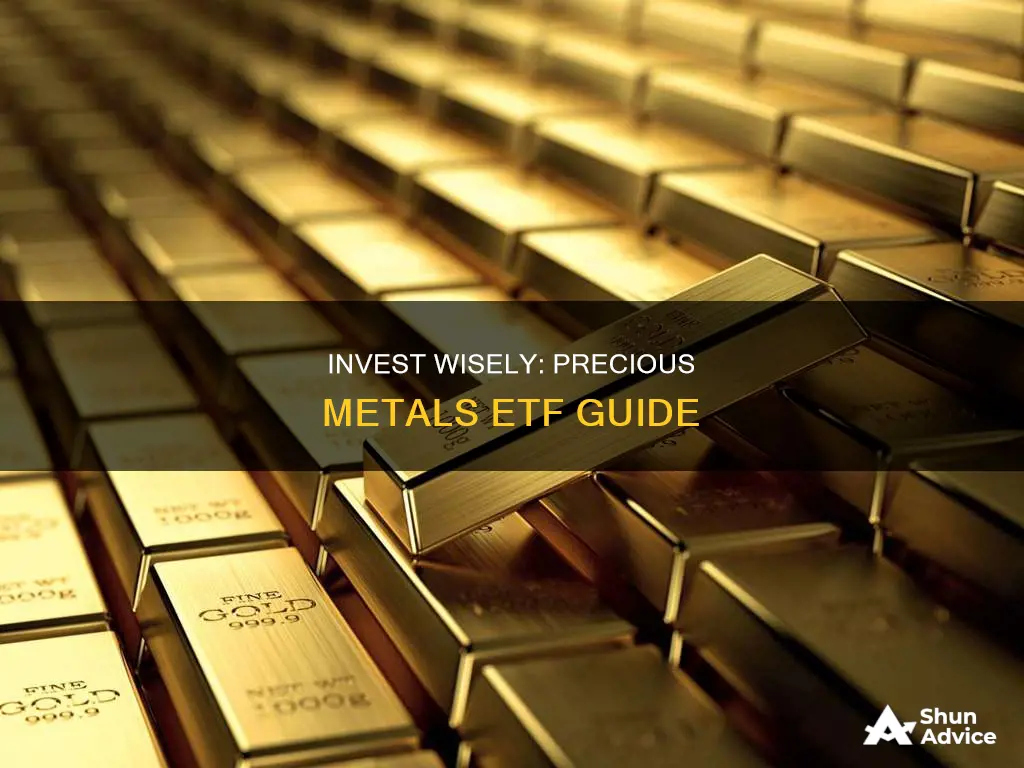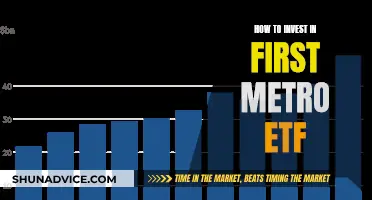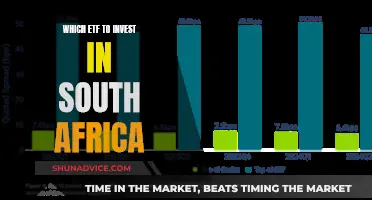
Precious metals exchange-traded funds (ETFs) are a popular way to invest in gold, silver, platinum, and palladium. These funds can provide exposure to these metals either through physical ownership or futures-based contracts. ETFs offer a more liquid and accessible approach to investing in precious metals compared to buying futures contracts, bullion, or stocks in companies involved in exploration and production. While the precious metals market has underperformed the broad US equity market over the past year, ETFs in this sector can serve as a hedge against inflation and market volatility. When considering how to invest in precious metals ETFs, it is important to evaluate the advantages, risks, and alternatives.
How to Invest in Precious Metals ETFs
| Characteristics | Values |
|---|---|
| Description | Exchange-traded funds (ETFs) that invest in precious metals such as gold, silver, platinum, and palladium |
| Investment Strategy | Exposure to precious metals through commodity futures or physical ownership |
| Benefits | Hedge against inflation and market volatility, convenient and cost-effective, low fees |
| Risks | High volatility, influenced by external factors such as global economy and geopolitical events |
| Example ETFs | iShares Gold Trust Micro ETF (IAUM), SPDR Gold MiniShares Trust (GLDM), Sprott Gold Miners ETF |
What You'll Learn

Precious metals ETFs vs. mining stocks
Precious metals such as gold, silver, and platinum are valued by many investors as a hedge against inflation or a safe haven in times of economic turmoil. They are also valued for their rarity and their use in a broad range of industrial applications.
Precious metals portfolios often focus on mining stocks, with most portfolios concentrating on gold-mining stocks, and some having significant exposure to silver, platinum, and base-metal mining stocks. Precious metals companies are typically based in North America, Australia, or South Africa.
Precious metals exchange-traded funds (ETFs) are a popular way to invest in these metals, either through physical or futures-based exposure. ETFs can offer a more liquid and easier approach to investing in precious metals than buying futures contracts, purchasing bullion, or buying stock in publicly traded companies involved in the exploration or production of these metals.
There are several ETFs focused on the metals and mining sector. Some ETFs focus on precious metals, including gold ETFs and silver ETFs, providing investors with broad exposure to the precious metals mining sector or a specific precious metal. Other ETFs concentrate on leading industrial base metals, such as aluminum, iron ore, and copper, as well as emerging metals for the green energy sector, such as lithium. Their strategies centre on holding metals-focused mining stocks or metals futures contracts.
When deciding between investing in precious metals ETFs or mining stocks, it is important to consider the level of risk and potential returns. Mining stocks can be more volatile, as their performance is tied to the operational efficiency and financial health of the mining company. They can also be more susceptible to market conditions and the price of the underlying metal. On the other hand, ETFs offer a more diversified investment, as they hold a basket of mining stocks or metals, which can help reduce the overall risk. ETFs also tend to have lower fees and provide easier liquidity.
In terms of returns, both options can provide strong returns, depending on market conditions. Historically, stocks have outperformed precious metals, but this is not always the case, especially during periods of high inflation or economic downturns. It is also important to consider the tax implications, as certain ETFs, such as those holding collectibles, may have significant tax liabilities on long-term gains.
The Easy Way to Auto-Invest in ETFs
You may want to see also

Gold ETFs
Gold is often seen as a safe haven for investors, especially during financial turmoil, as it can help stabilise equity and bond portfolios. Gold ETFs are ideal for investors who want to invest in gold but don't want the hassle of storing physical gold or are unsure about its purity. They are also a more liquid and accessible approach than buying futures contracts, bullion, or stock in gold mining companies.
When choosing a gold ETF, it is important to consider the five-year returns and the expense ratio, which is the annual fee paid out of your investment in the fund. The average expense ratio for gold ETFs is between 0.00% and 0.59% p.a.
- Franklin Responsibly Sourced Gold ETF
- IShares Gold Trust Micro
- SPDR Gold MiniShares Trust
- Abrdn Physical Gold Shares ETF
A Beginner's Guide to Investing in Grain ETFs
You may want to see also

Silver ETFs
- IShares Silver Trust (SLV): This ETF offers transparency, liquidity, and convenience, regularly disclosing the amount of silver held. It currently has over $9 billion in assets under management, representing around 13,600 tons of silver in trust.
- Sprott Physical Silver Trust (PSLV): PSLV is a closed-end fund, which means its shares may trade at a premium or discount to its net asset value. It holds $3.8 billion in assets under management, representing over 170 million ounces of silver held with the Royal Canadian Mint.
- Sprott Physical Gold and Silver Trust (CEF): CEF offers exposure to both gold and silver bullion in a single ticker. Its portfolio is currently 68% gold and 32% silver, with a combined $4.1 billion in assets under management.
- Global X Silver Miners ETF (SIL): SIL provides indirect exposure to silver prices by investing in silver mining and streaming companies. It tracks the Solactive Global Silver Miners Total Return Index, with a portfolio of 32 globally diversified companies, heavily tilted towards Canadian equities.
- Amplify Junior Silver Miners ETF (SILJ): SILJ focuses on smaller and riskier junior mining companies, which primarily focus on silver exploration and development. It provides greater diversification when investing in junior silver miners.
- ProShares Ultra Silver (AGQ): AGQ is a leveraged ETF that targets a daily return two times that of the Bloomberg Silver Subindex. It is suitable for short-term enhanced exposure to silver prices but is not recommended for long-term investors due to its high volatility and expense ratio of 0.95%.
These Silver ETFs offer investors a convenient and accessible way to gain exposure to the precious metal without the complexities and costs associated with buying and storing physical silver bullion.
A Beginner's Guide to ETF Investing with Zerodha
You may want to see also

Platinum ETFs
Platinum is a precious metal that is valued by investors as a hedge against inflation and a safe haven during economic turmoil. It is also used in a broad range of industrial applications, such as in the manufacturing of cars, jewellery, and electronics. Platinum exchange-traded funds (ETFs) are a popular way to invest in this metal, offering exposure to the market without the need to physically own and store platinum.
There are two main types of platinum ETFs:
- Grantor trusts: These ETFs hold physical bullion in vaults and administer the buying, storage, and sale of the bullion on behalf of the trust's owners.
- Exchange-traded notes (ETNs): These are unsecured debt securities that track an underlying index, such as the Bloomberg Platinum Subindex Total Return. ETNs invest in futures contracts that track the price of platinum, rather than holding the metal in physical form.
- GraniteShares Platinum Trust (PLTM): This ETF is structured as a grantor trust and aims to track the spot price of platinum after deducting fund expenses. It is backed by physical platinum held in a vault in London, which is inspected twice per year. The fund is listed on NYSE Arca and can be traded through an investor's brokerage account. As of September 2, 2022, it had a one-year trailing total return of -16.0%, an expense ratio of 0.50%, and assets under management (AUM) of $38.5 million.
- Abrdn Standard Physical Platinum Shares ETF (PPLT): This ETF is also structured as a grantor trust and tracks the spot price of platinum after deducting fund expenses. It trades on the NYSE Arca electronic exchange and is backed by physical platinum held in secure vaults in London and Zurich. As of September 2, 2022, it had a one-year trailing total return of -16.8%, an expense ratio of 0.60%, and AUM of $924.1 million.
- IPath Series B Bloomberg Platinum Subindex Total Return ETN (PGM): This ETF is the only platinum fund structured as an ETN. It is designed to provide exposure to the Bloomberg Platinum Subindex Total Return and invests in futures contracts, rather than holding physical platinum. Due to its low trading volume, the PGM may have higher overall trading costs compared to more liquid investments. As of September 2, 2022, it had a one-year trailing total return of -18.0%, an expense ratio of 0.45%, and AUM of $4.6 million.
ETFs: A Pooled Investment Option for Diversified Portfolios
You may want to see also

Palladium ETFs
Due to the concentration of palladium production and the small size of the palladium market, prices can be volatile. For example, prices rose to over $3,000 per ounce in May 2021 before plummeting to less than $1,600 by December of the same year.
- Aberdeen Standard Physical Palladium Shares ETF (PALL): This is perhaps the largest and purest palladium ETF. As of Dec 31, 2021, the fund held more than 181,391 troy ounces at a secured vault in London. The fund was founded in December 2009 and, as of Feb 28, 2022, has returned 14.91% annually since its inception. The annual expense ratio is 0.60%.
- Sprott Physical Platinum & Palladium Trust (SPPP): This ETF holds physical bullion as opposed to derivative securities. As of March 4, 2022, the ETF held more than 58,000 ounces of platinum and 43,000 ounces of palladium. As of Jan 31, 2022, the ETF has returned around 5% annually since its inception in December 2012. The fund has an annual expense ratio of 1.07%.
- Aberdeen Standard Physical Precious Metals Basket Shares ETF (GLTR): This ETF invests in a number of precious metals, including gold, palladium, platinum, and silver. As of Dec 31, 2021, the fund held 305,575 ounces of gold, 61,103 ounces of palladium, 40,771 ounces of platinum, and 11.2 million ounces of silver. The fund has returned around 1.5% annually since its inception in October 2010. The annual expense ratio is 0.60%.
Electric Vehicle ETFs: A Guide to Investing
You may want to see also
Frequently asked questions
Precious metals ETFs are funds that invest in gold, silver, platinum, and palladium. They can provide exposure to these metals either through commodity futures or by physically owning the metal.
Precious metals ETFs can serve as a hedge against inflation and market volatility. They are also a convenient and cost-effective way to invest in precious metals without the need for physical storage. Additionally, they typically have lower fees compared to managed funds or purchasing physical gold.
Precious metals ETFs are highly volatile and susceptible to external factors such as changes in the global economy, geopolitical events, and currency fluctuations. These factors can make it difficult to predict their performance, adding a layer of risk for investors.







